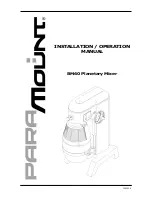
OPERATIONAL & APPLICATION NOTES
MODEL CS 208
21
Inputs:
XLR In:
Transformer balanced input. Nominally Pin 2 high. (Pin 3 - low, Pin 1 - ground).
Channel Power:
To conserve current consumption, switch off unused channels. Do not switch during recording.
Mic Power Select:
Mic power off. For example, dynamic and radio microphones. T-power/AB power =
`
Unbalanced microphone powering, nominally Pin 2 is positive, for use with unmodified European
microphones. XLR must be reversed for ‘red dot’ microphones. Phantom power = Balanced
powering, positive DC voltage on both Pins 2 and 3, normally set for 48v (see application note
AN 2C). Do not switch to 48 volt with 12 volt phantom microphones.
Phase:
This affects audio phase only (eg: does not control the T-power polarity). N (normal) = Pin 2 high
R (reverse). It is important that the phase of the microphones are matched to avoid phase
cancellation. Absolute phase throughout the system should also be maintained.
Mic/Line:
Up = Mic, Down = Line. 40 dB pad.
Pad:
15 dB pad, effective in both mic and line positions. For typical SPL (sound pressure levels) pads
are not necessary due to the high system headroom. The use of pads will degrade the signal to
noise ratio if used within the range of the microphone gain trim. 40 dB pad may be used for
balanced line level signals.
HP1:
Pre-transformer filter (100 Hz, 6 dB/oct) for use where very high level, low frequency signals may
saturate the transformer and pre-amplifier. In general, because of the very high saturation point
of the Jensen Transformers (-6 dBu at 20 Hz), this filter is rarely necessary.
HP2
:
Is a post-preamp filter (70 Hz, 12 dB/oct). Sharp roll-off below 70 Hz to reduce microphone
handling noise and other low frequency disturbances. It is recommended to use this for
dialogue recording as the bandwidth of interest normally exceeds 100 Hz.
EQ:
Hard bypass switch does not affect H.P. filters. EQ-H.F. = (High frequency, shelving response).
Used to increase/decrease ‘brightness’ of signal. (eg: to reduce sibilance.) EQ-M.F. = (Mid
frequency). Center frequency variable from 500-5 kHz (eg: May be used to increase ‘presence’).
EQ-L.F. = (Low frequency, shelving response), may be used for a more gradual tapering of low
frequency signals.
AB In:
Assigns channel to AB mix busses via the pan pot.
Left Page
Left Page
Summary of Contents for CS 208
Page 14: ...BLOCK DIAGRAM MODEL CS 208 12...
Page 15: ...BLOCK DIAGRAM MODEL CS 208 13...
Page 16: ...EQ CHARTS MODEL CS 208 14 1 HP 1 2 HP 2 3 HP 1 HP 2 2 1 3...
Page 17: ...LAYOUTS MODEL CS 208 15...
Page 18: ...MODEL CS 208 16 LAYOUTS...
Page 19: ...LAYOUTS MODEL CS 208 17...
Page 20: ...CSST LAYOUTS MODEL CS 208 18...














































